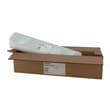LOCTITE ABLESTIK CDF 200
- High MSL reliability
- No resin bleed out
- 15um and 30um
Product Description
LOCTITE ABLESTIK CDF 200 highly filled, conductive die attach adhesive is designed to provide high thermal and electrical conductivity in the attachment of integrated circuits and components onto metallic leadframes. It can be used in a variety of die sizes ranging from 0.2mm x 0.2mm to 5mm x 5mm . This adhesive exhibits strong adhesion to various wafer metallizations and leadframe finishes
LOCTITE ABLESTIK CDF 200 offers high MSL reliability, controlled fillet size and does not exhibit resin bleed out. It has good wetting and low warpage on multiple die sizes and is recommended for thin wafer handling applications. It comes in 15 and 30um and is typically used for QFN, SOIC and SO package applications.
Cure Schedule
- 30 minute ramp from 25°C to 200°C, hold 60 minutes @ 200°C
- 30 minute ramp from 25°C to 175°C, hold 60 minutes @ 175°C
Technical Specifications
| General Properties | |||||||
| |||||||
| Thermal Properties | |||||||
| |||||||
| Glass Transition Temperature (Tg) Glass Transition Temperature (Tg) The glass transition temperature for organic adhesives is a temperature region where the polymers change from glassy and brittle to soft and rubbery. Increasing the temperature further continues the softening process as the viscosity drops too. Temperatures between the glass transition temperature and below the decomposition point of the adhesive are the best region for bonding. The glass-transition temperature Tg of a material characterizes the range of temperatures over which this glass transition occurs. | 15 °C | ||||||
| Thermal Conductivity Thermal Conductivity Thermal conductivity describes the ability of a material to conduct heat. It is required by power packages in order to dissipate heat and maintain stable electrical performance. Thermal conductivity units are [W/(m K)] in the SI system and [Btu/(hr ft °F)] in the Imperial system. | 2.3 W/m.K | ||||||
Additional Information
Films work like the “household double sided tape”. We can quickly appreciate the benefit as we used a dry resin for this, that results in a no mess assembly and very even BLT. Standard thickness of our films is 15um and 30um.
If your Z-space is really critical and has to have a very low BLT, Film is the way to go. Yes, there will be the additional process of laminating the film underneath you wafers but after that its all the same as traditional die attach process.

CDF 200P - Die attach film property comparison



